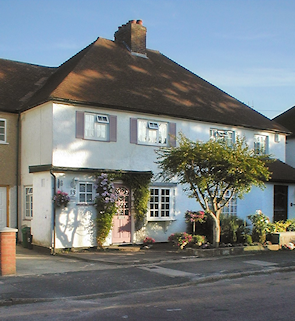Ruislip Manor
Ruislip Manor, Hillingdon
The south-eastern part of Ruislip, bordering Eastcote

A wooden halt opened at Ruislip Manor in 1912, when this was still open countryside. The station was completely rebuilt in its present form in 1938, to a design by Charles Holden.
Virtually all of Ruislip Manor was laid out as a single private housing estate by George Ball from 1933 to 1939, and called Manor Homes. The estate should not be confused with the original plan for the development of central Ruislip – which was initially called Ruislip Manor – nor with the Ruislip Manor cottage estate, north of the railway line.
George Ball acquired the land from King’s College, Cambridge, which had previously entertained the notion of creating a garden suburb here, along the lines of the one at Hampstead. The 2,238 houses were all built to one of two basic types, mostly in terraces of four or six, although a few were semi-detached.
The new homes were priced within the reach of working people, starting at £450, and many were sold to families from the north who had come to London to find work during the depression. Other buyers came from industrialised parts of West London, such as Acton, in search of an affordable rural retreat.
Nowadays, most adults in Ruislip Manor have some educational qualifications, but not a degree. At the 2011 census, 84 per cent of residents were white; down from 90 per cent in 2001.
The music hall stars Elsie and Doris Waters opened Ruislip’s first British Restaurant on Victoria Road in 1941. British Restaurants were wartime canteens, intended to feed the masses economically.
